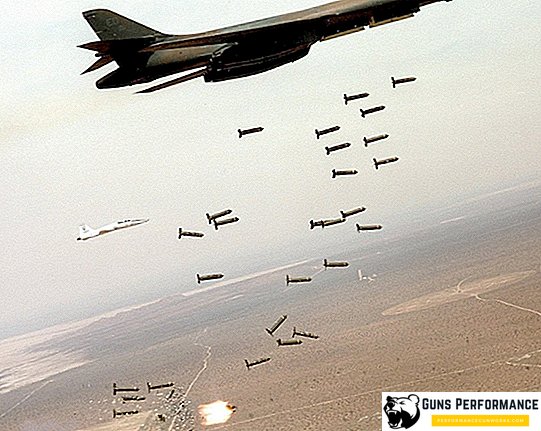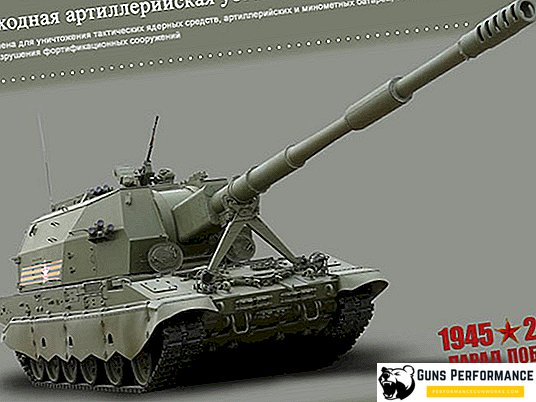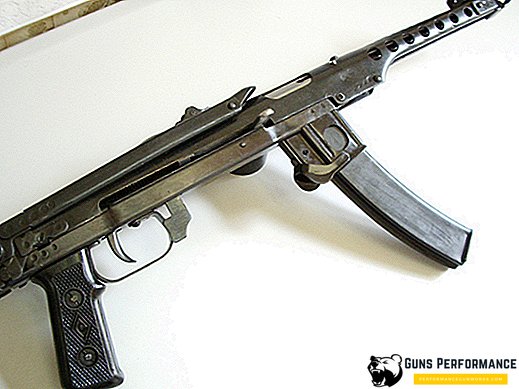The history of the development of the Russian army is in many respects a collective image, based on the military traditions of medieval Europe and the Ottoman Empire. The European army was borrowed military system, uniform and tactics of warfare. The technical equipment was equally represented by weapons and equipment of all types and types, which were used both in Europe and in the East. In each historical era in service with the Russian army, one type of weapon or another appears. Since the reign of the Moscow Prince Vasily II of the Dark, in the Moscow army, the ranks of the military militia are replenished with special military formations, with the soldiers of the army. These detachments were armed with long squeaks, and the shooters used an ax berdysh as an auxiliary combat weapon.

The weapon strongly resembled halberds that were widespread in Europe, which bore a slightly different purpose. Security weapons of the Turkish army were armed with similar weapons. Despite the fact that battle axes, pikes, halberds were used in almost all the armies of the world, berdysh can be safely attributed to the number of Russian "know-how". The Russian archer in a long red caftan, armed with food and a massive ax on a long pole, became a symbol of the military power of the Russian state in the Middle Ages. They didn’t squeak and the muskets became symbols of the Streltsy army, namely the Berdyshes. This weapon remained on the equipment of the Russian army until Peter I came to the kingdom, which subsequently abolished the artillery regiments.
Berdysh - where I am from
Axes have long been in service with armies. This melee weapon possesses tremendous penetrating power and, with skillful use, can inflict heavy, often fatal wounds to the enemy. Berdyshes, which appeared in the Middle Ages, are an improved two-handed type of melee weapon with a slashing action. In the process of upgrading the battle ax or ax, got a wider and stretched in length blade. For effective possession of such a tool, the shaft was extended.

Speaking about the origin of the name, German roots are most likely to be traced here. The word is consonant with the Polish name of the battle ax, berdysz, which, in turn, is a German war ax with a wide blade, barda. An example of the consonance of the name is hellebarde, a similar weapon in service in Western Europe. In the Russian interpretation of the weapon, it took root with the Polish name, eventually obtaining a native Russian residence permit.
Argued that the Moscow army took over this type of cold arms from the Turkish army, along with ammunition and equipment. The Ottomans were also armed with battle axes with a long blade - tirpan. The shape of the crescent-shaped blade speaks in favor of this theory of the origin of the weapon.

From a technical and constructive point of view, the Berdysh is a type of ancient weapon - the ax, which has long been considered the main combat weapon of the infantry in the dark ages and in the early Middle Ages. With the advent of firearms, slashing cold weapons lose their dominant position on the battlefield. Axes, axes go into the category of auxiliary weapons. In Europe, reefs or halberds are becoming an auxiliary weapon for security units and fiery combat regiments. First, in France and in Spain, a little later in Germany, the long ax, along with the pikes, remains the main weapon of the line infantry regiments. The Berdyshes that appeared in the XIII-XIV centuries in service with the royal regiments in Poland, successfully migrated to the Moscow army, becoming one of the main weapons for the militia.
The main part of the Russian army in the Middle Ages was represented by the militarized militia. The infantry was armed with a variety of weapons. The appearance of the Berdysh significantly increased the combat capabilities of the infantry lines, which could now successfully withstand enemy cavalry and fight on equal terms with the spearmen and pikemen. The first combat use showed clear advantages of new weapons for the Russian army. Heavy and long blade, reinforced with a long shaft, can cut through the steel armor of heavy cavalry. Particularly successful was the use of felts against long spears. Skillful and powerful blows of the ax have broken the spears of enemy infantry. After that, the entire weight of the steel ax fell on the heads of the disarmed spearmen.

By changing the grip, an armed militiaman could effectively defend himself while simultaneously attacking attacks, striking the enemy directly with the blade or the edge of his weapon. In the early versions, the birdish had a sharp steel tip at the end of the shaft, which was used to defend against attacking cavalry.
Features of a design and manufacturing techniques of bears
The main and distinctive feature of this weapon is its cheapness. A durable and wide blade can be made from even the lowest grade steel. In the manufacture of axes did not require special blacksmithing skills and special metal processing technology, so the bells were forged in droves. Weapons were used to equip the militia, which was mainly staffed by the poor. Long axes, axes and berdysh became the favorite weapon of the Moscow army in that era.
Only a few specimens, made of quality steel, was a real professional weapon, distinguished by the beauty and quality of finish. As a rule, such berdyshes were used in ceremonial actions and went to the recruitment of palace guards.

It should be noted that at first glance a berdysh is a weapon that does not differ in the complexity and intricacy of the structure. In fact, the product successfully combines the simplicity of the design and its high combat effectiveness. Like any ax, this weapon has a blunt rear part - a butt, which was blunt. A distinctive feature of the berdysh is the presence of a braid, an elongated and pulled down part of the blade. It is this element of the design that distinguishes the berdysh from the ax and the battle ax. Kositsy served as an additional fastener with which the metal part was attached to the pole. Due to the kositsy blade received the necessary stability. When swinging and hitting, the blade of a berdysh does not vibrate thanks to a braid and retains its straight-line position relative to the shaft.
Berdyshes used in the Russian army were distinguished by their design. In each region of the Russian State for the manufacture of weapons used their own technology. Accordingly, the weapon had a different blade length. As a rule, the blade length varied in the range of 20-100 cm. The weight of the steel part of the smallest specimens could be 600 g and 1.5 kg. in the largest and longest samples. In later versions of the weapon, the weight and length of the blade were significantly greater than that of the first samples of this weapon.

The shaft or rattle for axes used by the militia had an oval cross section. For special units were made reed with a shaft, having an octahedral cross-section of 4x2.5 cm with a length of 1-2 meters. In the Polish army and in service with the Ukrainian Cossacks, they were 120-140 cm long. In the army of Tsar Ivan III, the artillery regiments had 150-170 cm long beads. Samples of weapons adopted by the Russian army were considered the heaviest, just over 3 kg.
Combat use of bears
Berdysh as the main weapon of the Russian infantry earned fame as a formidable and powerful weapon. Poles and Lithuanian troops, who actively fought with the Russians in the Middle Ages, took upon themselves the brunt of the strike of the Russian infantry, armed with heavy long axes. Polish cavalry, which sowed panic in the ranks of the defending troops, tried to avoid the Russian regiments, where the soldiers were armed with axes and berdsh. "In the cramped hand-to-hand combat, neither the iron armor nor the steel helmet could guarantee protection against the crushing blow of the Russian ax. The Russian militia, armed with wolf-tails, spears and spears, could withstand the attacks of our cavalry for a long time, inflicting heavy losses on our riders." This is how the Lithuanian cavalryman, who acted as a member of the Lithuanian army of Nikolai Radzivil in the Battle of Chashniki, described acquaintance with the Berdysh.

Already later, the Polish army of Stefan Batory was tested on the power of the shooter's army of Ivan III, armed with tins and long berdsh. This weapon was often the last weighty argument in the thicket of victory during the hand-to-hand combat. Sagittarius, acting on foot, first struck a blow to kill, causing confusion and panic in the advancing troops. After the shot, the archer became a fencing master, skillfully wielding a heavy and long ax.
The tactics of combat in the militia was much easier. Most often, with the help of berdys, there were set up zaseki, primitive fortification field fortifications, capable of stopping the enemy’s attacking cavalry. In hand-to-hand combat, a militiaman armed with a berdysh could dump a rider or withstand an attack of the enemy’s lightly armed infantry.
In addition to the Polish and Lithuanian troops, which at that time represented the main enemy, Russian archers were equally successful in the South against the Turkish and Turkish-Tatar forces.
Turkish troops rarely could successfully knock down archery regiments. “They squeaked, muskets and berdyshi allowed the Ottomans to give a fitting rebuff. The enemy attacking the Russian trenches and aprosy was forced to withdraw from the battlefield, leaving mountains of corpses on the ground,” says Colonel Gordon about the actions of the Russian army in the battle of Chigirin in 1677.

It should be noted that, beginning in 1656, in the Russian army, a royal decree introduced standardization of bears. From this point on, all the blacksmith artels and workshops engaged in the delivery of state property for the army, made axes strictly according to the samples presented. In accordance with the decree, the berdysh was supposed to have a shaft length of 1.42 m. The shaft in the lower part was equipped with an iron tip, which allows you to stick weapons into the ground. The quality of the metal and the manufacturing method have not changed, so the royal treasury did not suffer much from the mass production of such weapons. The massive use of this type of cold weapon in the Russian army by a number of military experts and historians explains the ease of learning how to own a battle ax. In contrast to the saber and the sword, which required learning the art of fencing, it was much easier to wield a tang in the battle.
In the absence of physical defects, any physically strong person could possess cold arms. With a certain experience and skill, such a warrior in battle was a formidable force. Strelets Troops underwent a special course of study, during which they worked out methods of attack and defense using firearms and cold arms.
Finally
Sagittarius, shooting from a peep from a berdysh stuck in the ground, a typical image of a Russian warrior of that time. The use of edged weapons as a stop for accurate shooting was common practice. In the European armies, musketeer regiments used swords for these purposes, whereas in the Russian army these tasks were carried out by a berdysh. Often, a wide ax blade was used as a protective tool, protecting shooters from enemy fire.
The Russian regiments had on the equipment berdys of different designs and types, with a regular or with a developed feather - yelman. Each type of ax in turn was divided into several subspecies, but one should distinguish between military weapons and ceremonial ones. The last copies had a lightweight construction, often equipped with carved elements, gold and silver embossing. In the marching order, the berdysh was worn behind his back, fastened to the warrior’s body with the help of a belt.
This weapon remained on the equipment of the Russian army until the onset of the XVIII century, when the regiments of the "European system" replaced the archers. The Russian army under Peter I half consisted of infantry regiments of the new type and archer regiments. Only after the Streltsy riots swept in Russia, by the tsar's decree, the archery regiments were abolished. Silicon guns, along with the berdysh went into the category of exhibits for the arsenal. Now the Berdyshes can be found only in the museum, where in the expositions of the Russian Tsar era of pre-Peter the Great, these weapons are presented together with the Strelets form.












